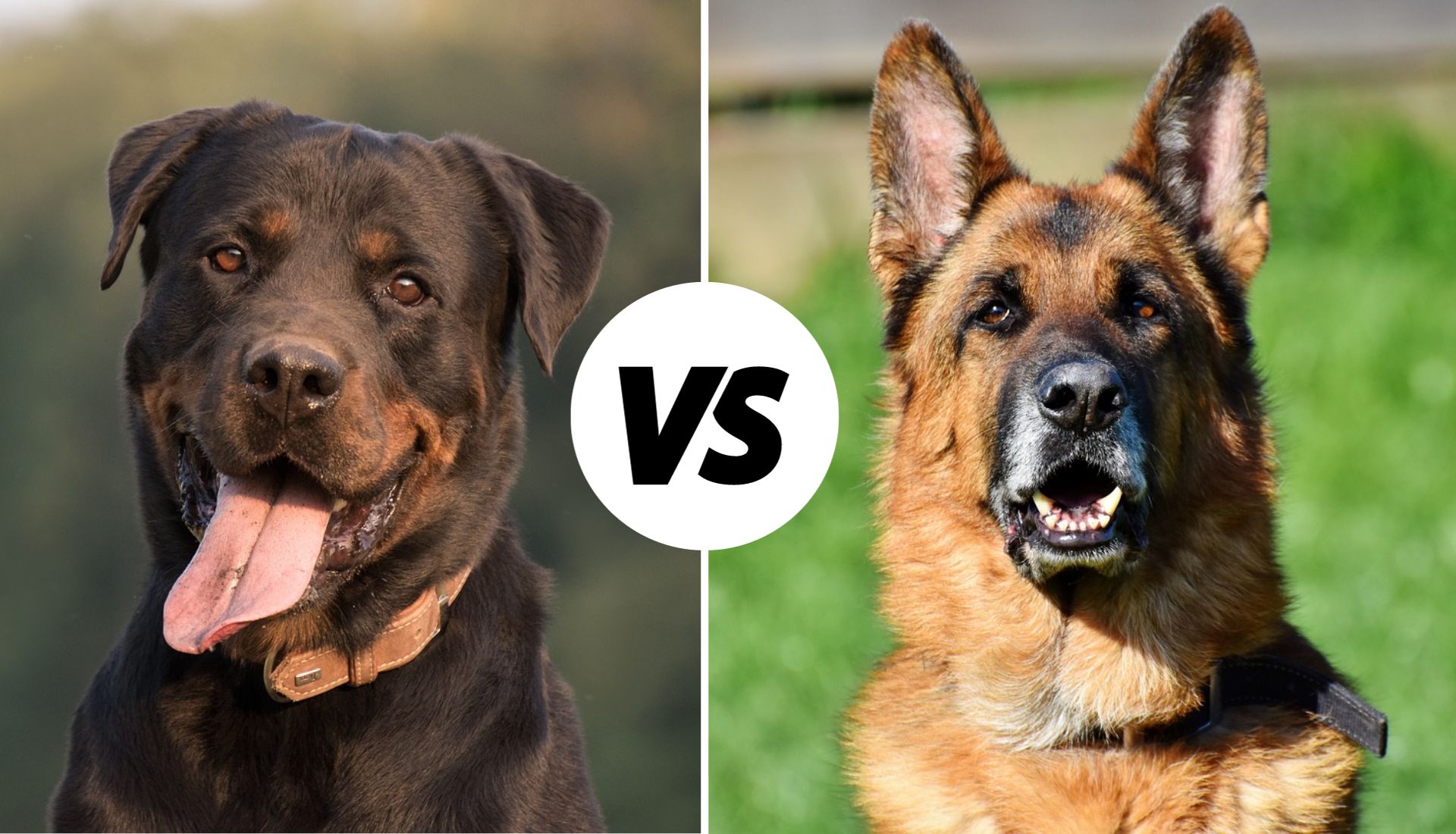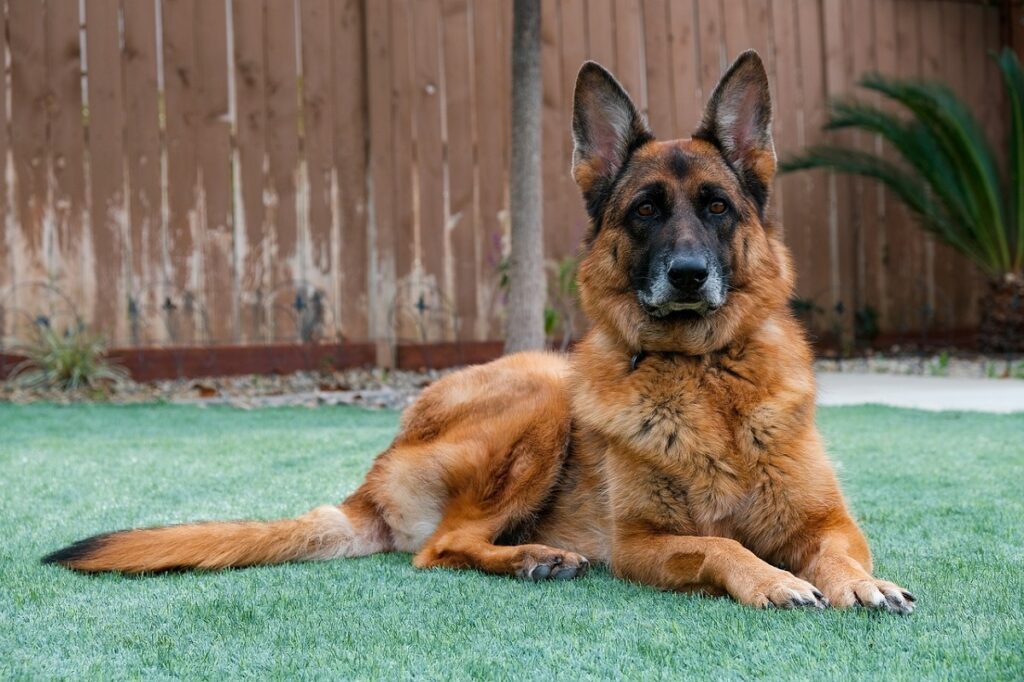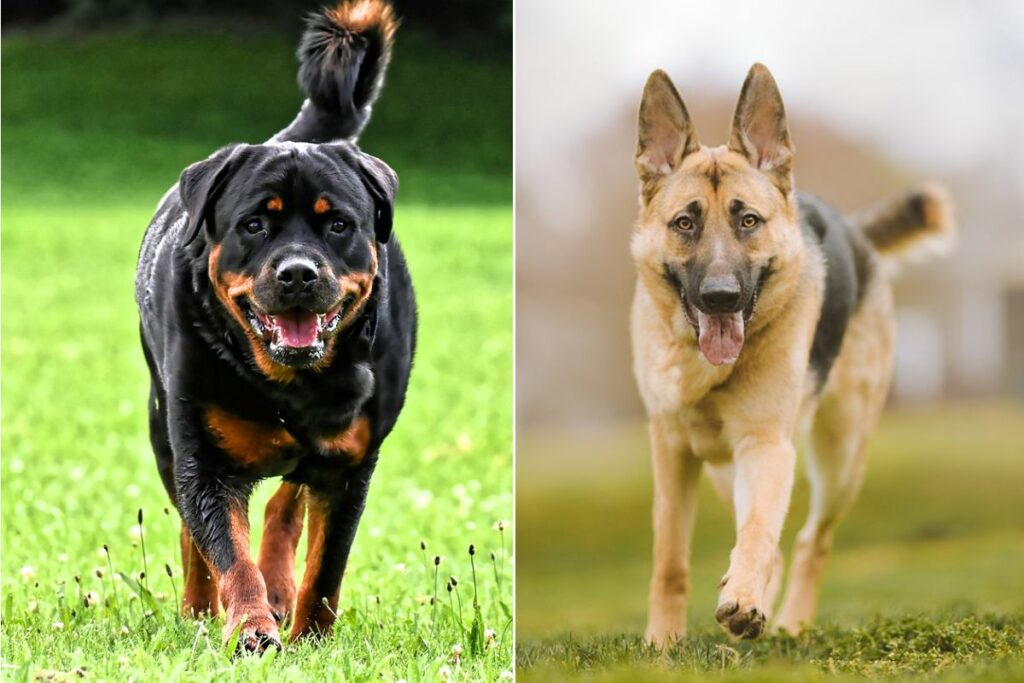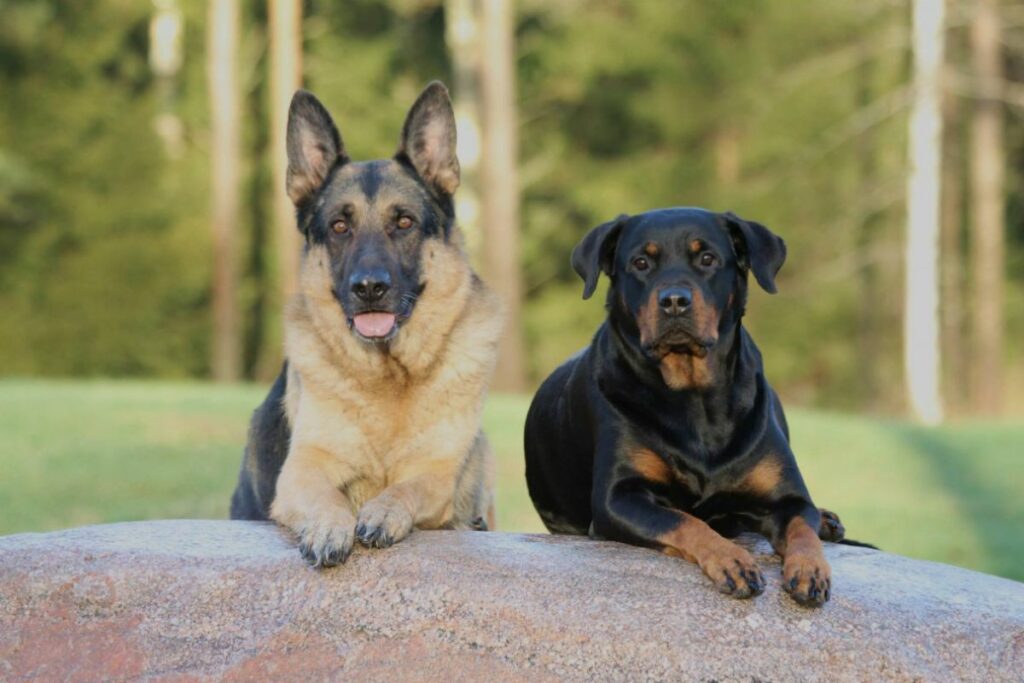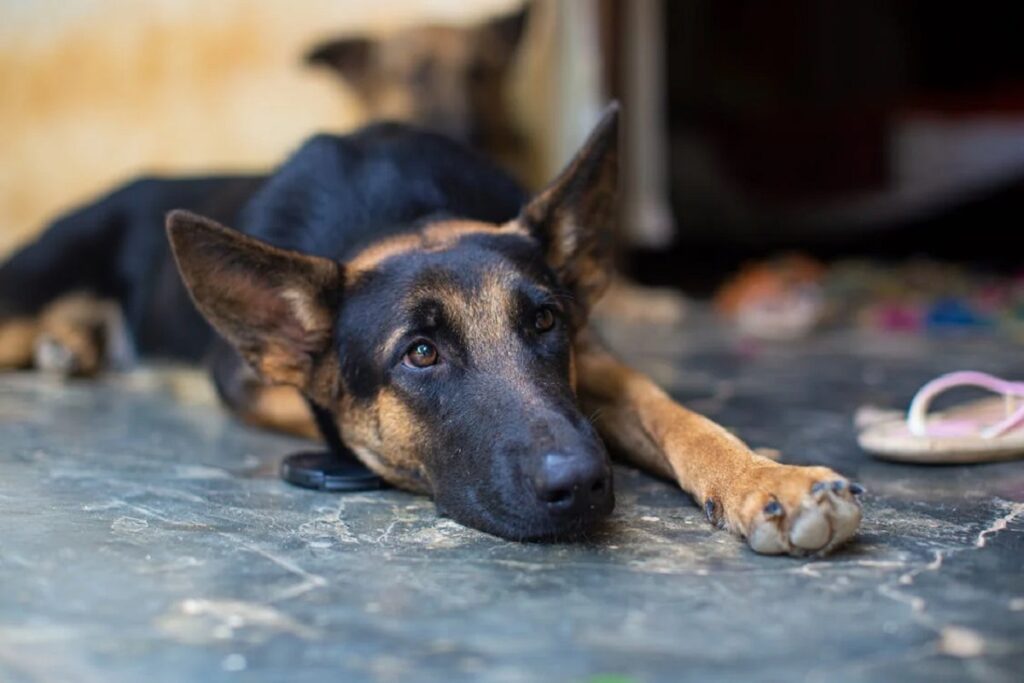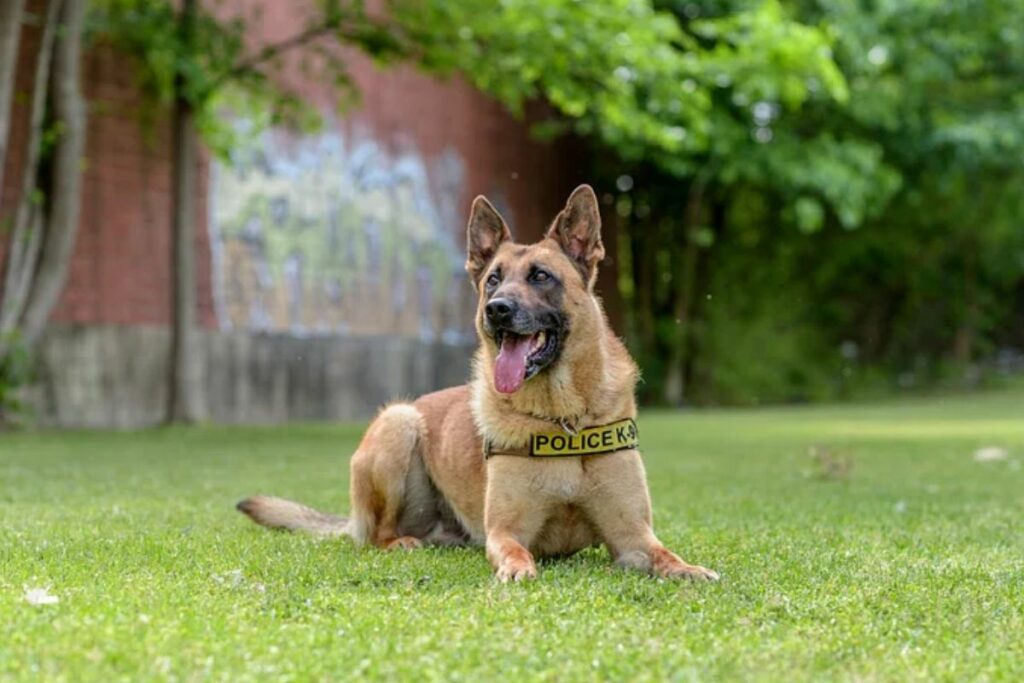Rottweilers and German Shepherds, two of the most popular large breed dogs, often evoke both admiration and apprehension. While both are intelligent and powerful, key differences separate these imposing breeds. From their origins as cattle herders and guardians to their modern roles as family companions and working dogs, distinct traits shape their temperaments, trainability, and health predispositions. Unpacking these nuances will help you understand which breed, if either, is the right fit for your lifestyle. This exploration delves into the “Rottweiler vs. German Shepherd” debate, highlighting the critical distinctions between these remarkable canines.
Meet the Rottweiler and German Shepherd: two of the most beloved dog breeds known for their loyalty and courage. Despite both hailing from Germany, they each have unique roles – the Rottweiler as a robust working dog and the German Shepherd as a skilled herder.
Rottweilers and German Shepherds excel as police, military, and service dogs thanks to their intelligence and dedication. With early training, they also become fantastic family pets and reliable guard dogs, seamlessly blending into home life with their protective nature. But their differences go beyond just their jobs.
Let’s dive into what sets these two remarkable breeds apart and discover which one might be your perfect match.
Rottweiler vs. German Shepherd
Rottweilers, affectionately known as Rotties, often face misconceptions, yet their reputation is quite undeserved. Originating in the Roman Empire, they were initially herding dogs, evolving into trusted guardians due to their innate protective instincts.
The German Shepherd breed, crafted by Max von Stephanitz from traditional German herding dogs in 1899, began as sheep herders. Over time, they’ve adapted to various roles beyond herding, showcasing their versatility and intelligence in numerous fields of work.
Here’s a concise chart to quickly highlight the basic differences between Rottweilers and German Shepherds:
| Height | 24 – 27 inches (male)22 – 25 inches (female) | 24 – 26 inches (male)22 – 24 inches (female) |
| Weight | 95 – 135 lbs (male)80 – 100 lbs (female) | 65 – 90 lbs (male)50 – 70 lbs (female) |
| Colors | Mahogany, Tan, Rust, Black | Silver, Tan, Red, Black |
| Coat type | Short, Dense | Fuzzy, Heavy Shed |
| Social Needs | Very High | Average |
| Personality | Independent, Courageous, Protective | Alert, Obedient, Intelligent, Loyal |
| Bite Force | 328 psi | 238 psi |
| Health Risks | Bloat, Hip Dysplasia, Hypothyroidism | Blindness, Bloat, Paralysis, Lupus |
| Life span | 9 – 10 years | 7 – 10 Years |
Appearance
Though both Rottweilers and German Shepherds are large breeds, they have notable differences. Rottweilers range from large to giant size, potentially weighing twice as much as a German Shepherd. They also have distinct physical characteristics and social needs.
Let’s delve into these differences…
Size
Adult male German Shepherds typically stand 22 to 26 inches tall from paw to shoulder. In comparison, male Rottweilers have an average height of around 24-27 inches. When it comes to weight, a fully grown male Rottweiler averages about 95-135 pounds, significantly heavier than the average German Shepherd, which weighs around 65-90 pounds.
Colors
Rottweilers wear black and mahogany coat colors like a sleek, well-fitted suit, with tan to rust markings that accentuate their robust frame, giving them a look of both power and poise. This classic black and mahogany ensemble is indeed the signature of the breed.
German Shepherds’ wardrobes are a bit more diverse; they commonly don the classic black and tan. These canine companions can also be found in an array of colors like silver, tan, red, and black.
Coat type
The Rottweiler sports a flat, straight, and coarse outer coat with a softer undercoat on its neck and thighs. The German Shepherd’s coat is similar but denser, with a thick, plush undercoat beneath its close-lying outer hairs.
Characteristics
Rottweilers are loyal but protective, with a strong instinct to guard, and can be reserved with strangers. In contrast, German Shepherds are known for their sociability, trainability, and obedience, often preferred for police and military roles due to these traits.
Consider these behavioral differences when choosing your breed. For a deeper understanding of these temperament differences, further details are provided below:
Personality
A well-trained Rottweiler exudes confidence and is quite the powerhouse—active, strong, and not one to wind down easily. They approach new arrivals with a reserved demeanor. Rottweilers stand as vigilant sentinels, fearless, and deeply attached to their families. They lean towards bold independence, contrasting with the German Shepherd’s more obedient nature.
German Shepherds are known for their unwavering loyalty to their owners and are amiable and great with children, yet they remain cautious around other dogs. German Shepherd is the epitome of loyalty, always ready to protect their family, even at personal risk.
While not inherently friendly, their trust is a prize earned through time and patience. They are naturally cautious around strangers, quickly switching to protective mode if they perceive a threat to their loved ones.
Intelligence
Both the German Shepherd and Rottweiler are celebrated for their intelligence, with the German Shepherd ranking third behind the Border Collie and Poodle for work intelligence and obedience, as per Dr. Stanley Coren’s study. The Rottweiler holds an impressive ninth place, indicating it learns swiftly, though not as rapidly as the German Shepherd.
The calm and brave Rottweiler thrives under the guidance of an experienced owner committed to their training and socialization. Meanwhile, the highly intelligent German Shepherd, less willful and eager for praise than the Rottweiler, is often easier to train.
Strength
Both the Rottweiler and the German Shepherd are formidable in their strength, with the Rottweiler having a slight edge due to its more muscular build, designed for carrying and pulling heavy loads. The German Shepherd, while strong, is notably more agile.
When comparing bite force, the Rottweiler leads with a force of 328 pounds per square inch (psi), surpassing the German Shepherd’s 238 psi. Despite these powerful capabilities, with proper training, neither breed is inherently aggressive, and both serve as loyal protectors.
Social Requirements
Rottweilers, known for their sociable nature, crave significant attention and can suffer from severe separation anxiety if left alone. They need frequent social interaction but are less tolerant of strangers, children, or other pets. Best suited to an environment with trusted individuals, they flourish with proper guidance and exercise.
In contrast, German Shepherds are generally more amenable to children and strangers. They can tolerate being alone better than Rottweilers, though still not for long stretches. Adaptable to typical social needs, they are exceptionally devoted and attentive to their owners, displaying a strong bond.
Health Risks
Both Rottweilers and German Shepherds are generally healthy dogs when properly cared for, but as large breeds, they are susceptible to certain health conditions like hip and elbow dysplasia. Rottweilers are more at risk of ailments such as dilated cardiomyopathy and hypothyroidism, while German Shepherds are prone to bloat and degenerative myelopathy.
Proper nutrition is key for these breeds. Both benefit from high-quality dry or wet food formulated for large breeds. It’s crucial to manage their diet carefully, as they can easily gain weight if overfed and under-exercised, which can strain their joints.
Life Span
Rottweilers typically have a lifespan ranging from 9 to 10 years, whereas German Shepherds can live between 7 and 10 years. Unfortunately, Rottweilers are prone to various health issues that can significantly shorten their lifespan without proper care.
Why German Shepherds are Preferred by Police Forces Over Rottweilers
German Shepherds excel as police dogs due to their intelligence, strength, agility, and eagerness to work, along with their ability to remain composed under pressure.
While Rottweilers are also smart and trainable and have been used in law enforcement, they don’t match the athleticism and endurance of German Shepherds. Their sense of smell, though keen, isn’t as sharp as that of a German Shepherd.
In police work, a Rottweiler’s strength can sometimes be a disadvantage, as situations often require more finesse and less force to minimize harm during apprehensions.
Final Thoughts
Choosing between a German Shepherd and a Rottweiler depends on your personality and theirs. The two breeds are loyal, loving, and protective family dogs. German Shepherds are slightly easier to train and need more exercise, while Rottweilers are more playful and have a larger appetite.
Like Golden retrievers, they’re generally healthy with similar lifespans. Grooming needs are similar, though long-haired German Shepherds require more care and shed more. Ultimately, both make excellent guard dogs and family dog, ensuring a loving and faithful canine companion in either choice.
Ultimately, both Rottweilers and German Shepherds are intelligent, loyal, and powerful breeds requiring experienced owners. While German Shepherds often excel in roles requiring agility and endurance like police work, Rottweilers’ strength and protective instincts make them excellent guard dogs. Choosing the right breed depends on individual lifestyle and experience. Prospective owners should carefully research both breeds, considering temperament, training requirements, and exercise needs to ensure a harmonious and fulfilling partnership.

